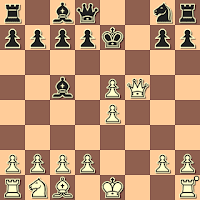Thomas Hobbes, in his Leviathan, (1651), wrote about life in the "natural state of mankind" before the establishment of a central government as being "solitary, poor, nasty, brutish, and short".
A Jerome Gambit (1.e4 e5 2.Nf3 Nc6 3.Bc4 Bc5 4.Bxf7+) game features an attack that often delivers that "natural state" to the defender.
It is important to remember, however, that in certain Jerome Gambit variations, effective (sometimes protective) central pawns are necessary for White, without which there can be dire consequences - as I learned quickly in my game four months ago, perrypawnpusher - Alfil_7, 3d/move, Piano Piano, Chess.com, 2021 (0-1, 13).
Of course, it was only a matter of time before I faced the same defense / counterattack again. It was not an easy matter.
perrypawnpusher - jonmather
3d/move, "Giuoco Piano" tournament, Chess.com, 2021
1.e4 e5 2.Nf3 Nc6 3.Bc4 Bc5 4.Bxf7+
4...Kxf7 5.Nxe5+ Nxe5 6.Qh5+ Ke6
7.Qf5+ Kd6 8. f4 Kc6
I call this the "Sillycon Defense", as can partly be explained by earlier posts
Nine years ago, I presented Philidor1792 - NN, casual game, 2012 (0-1, 17), and commented
A new move, as far as I can tell. When you are two pieces up, as Black is, you can simply give one back, and remain with the advantage.
The anonymous NN was not soon alone: VMACforever - Sillycon, standard, FICS, 2013 [1.e4 e5 2.Nf3 Nc6 3.Bc4 Bc5 4.Bxf7+ Kxf7 5.Nxe5+ Nxe5 6.Qh5+ Ke6 7.Qf5+ Kd6 8.f4 Kc6 9.Qxe5 Nf6 10.d4 d6 11.d5+ Kb6 12.Qc3 a5 13.a3 Nxe4 14.Qb3+ Ka6 15.Be3 Qh4+ 16.g3 Nxg3 17.Qd3+ b5 18.a4 Re8 19.Qxb5+ Ka7 20.Qxe8 Ne4+ 21.Kd1 Bg4+ 22.Kc1 Bxe3+ 23.d2 White resigned] was played a year later. Since Black in that game was a 2369-rated computer program, it is tempting to label 8...Kc6 the "Sillycon defense".☺
Can Black's King simply walk away from his Knight like that??
The remainder of the game suggests that he can.
One year ago, when I presented the game Lc0 - Stockfish 11, 2020 (0-1, 43), I warned "Jerome Gambit: The Future Is Here".
Then came the crushing perrypawnpusher - Alfil_7, 3d/move, Piano Piano, Chess.com, 2021.
I would like to point out that Black's King's abandonment of his Knight looks silly at first glance (White thinks "Well, then I will just take the piece"), but the move is part of a deeper "con" - to get someone to believe something by use of trickery - that includes danger down the e-file, which will often contain White's Queen and King.
9.Qxe5 Nf6 10.d3
There are 18 games in The Database with the aggressive alternative, 10.d4. The main idea behind the move is that if 10...d6 then 11.d5+, pushing Black's King toward the Queenside where an attack on it might prove fatal. Results show this hope to be overly optimistic, however, as White scores 22% in the line.
I chose the text move because I wanted as much support for my e-pawn as possible.
10...Re8
Another piece targets White's center. The Database has only one other example, but it certainly looks like the right idea. Also effective is 10...d5.
11.Qg5
The attacking idea behind this move was a bit misplaced - as was Black's King. There is nobody home on the Kingside to attack.
The defending idea behind this move was more motivated - to exchange Queens in the event that Black tries to break through the center with a piece sacrifice.
I need to rethink this variation. Some tentative new ideas follow.
[to be continued]




























